Massage is a specific system of influencing the body for the purpose of treating and preventing various diseases. Basic massage techniques are widely used in medicine, cosmetology, sports and in everyday life. A detailed description of each technique will help you understand in more detail how to do massage. Few people know that the procedure consists of three main parts: preparatory, main and final.
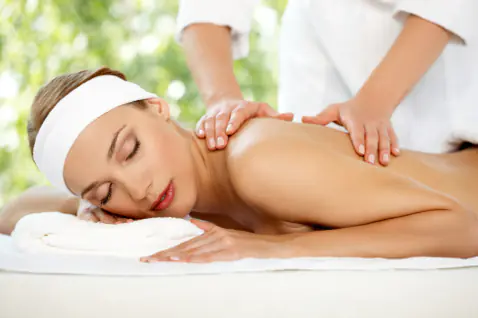
Before doing a massage, you need to prepare and warm up the body
- The preparatory part includes the basic techniques of classical massage: rubbing, stroking and kneading the main muscle group:
- The main part consists of special segmental massage techniques;
- The final part includes techniques of stroking, stretching and shaking the muscles.
During the session, the patient lies on his stomach, head turned to the side, arms extended along the body.
Basic Techniques
The massage consists of five main techniques: stroking, kneading, rubbing, tapping and vibration. Each technique carries certain information and function. Therefore, using various massage techniques, you can have a special impact on different parts of the body: blood vessels, muscles, nerves, internal organs.
To better understand the technique, let's study each technique separately.
Stroking
In other words, stroking is called "efleurage", which means "to caress" in French. As a rule, this technique begins and ends the entire procedure. It should be used after each subsequent dose, after applying massage oil to the skin. The movements are smooth, soft, gentle, soothing, with stronger pressure in the direction of the heart, and less forceful in the opposite direction. This promotes the outflow of venous blood and lymph. The hands should be positioned as follows: the fingers are pressed tightly, the palms completely follow all the contours of the patient’s body. This technique is performed without stopping and taking the hands away from the body.
In particular, this massage technique is divided into: straight, circular and wave-like.
- Straight-line stroking
Straight-line stroking occurs as follows: the hands should be pressed tightly to the body, with light, slightly pressed smooth movements it is necessary to slide up and down. With each subsequent time, try to capture a larger area of the body.
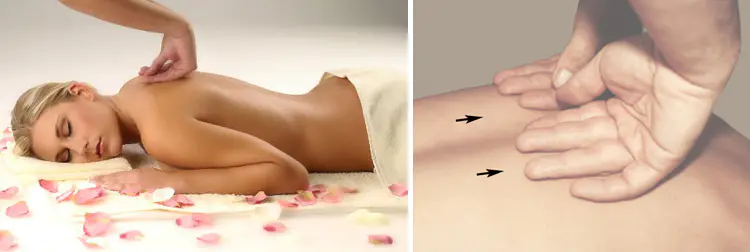
The image shows the technique of straight stroking
- Circular stroking
The hands are pressed tightly to the surface of the body, we make smooth large circular movements with our hands, alternating the right and left hands. Cover as much body surface as possible. Start at the top, gradually moving down. Having reached the very bottom, return to the starting position.

Circular stroking
- Wave stroking
The wave-like technique is as follows: during a straight-line massage, having reached the top of the back, you need to gently return to the starting position, thereby making wave-like movements downwards.
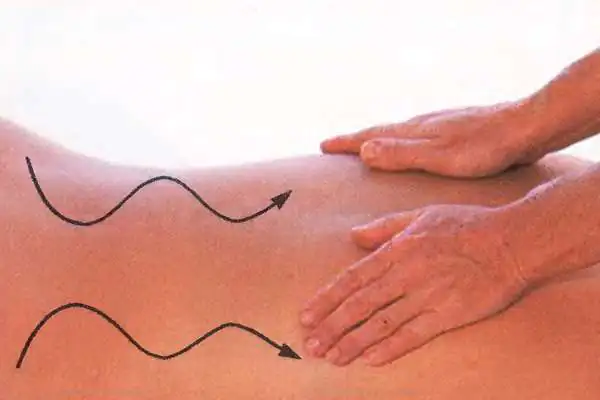
Soft wave-like movements from bottom to top
Massage with moderate and deep pressure
Any massage process begins with stroking, further accompanied by rubbing and kneading with stronger pressure on the skin and tissue. This pressure is applied using the fingers, the base of the palm and the edge of the palm. In this case, the massage therapist needs to skillfully use not only the strength of his hands, but also the weight of his own body.
Kneading can be done using the thumb. This type is called "petrisage". The characteristic of this technique is its effect on the muscles adjacent to the bone. Strength in your fingers won't hurt here.
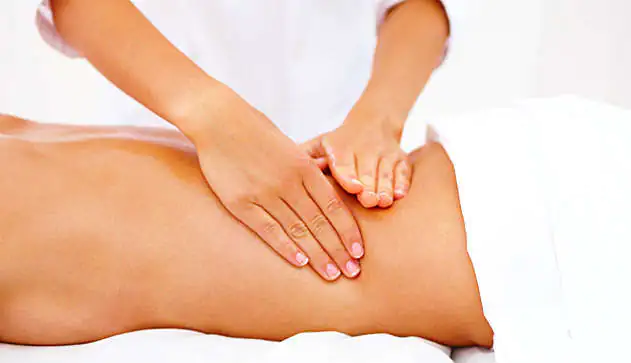
We move on to the technique with deep and moderate pressure
Kneading, rubbing, and tissue displacement helps remove toxic substances, improve blood circulation and accelerate metabolism.
After each use of a certain technique, ask the patient about pain sensations, since each person has his own pain limit. Massage with moderate and deep pressure can be divided into: kneading, stretching, kneading with fingers in the opposite direction and kneading with fingers from yourself.
- Kneading
Kneading is done as follows: grab the required area of the body with one hand, grab the muscles with the other, as if rolling with light effort. Then press with your second hand and knead with the first. Alternating both hands, walk this way over the entire body.
- Stretching
With one hand we press the skin, with the edge of the other hand we gently begin to pull back the soft tissue. Then move your right hand to the next area of skin, doing the same technique.
- Counter kneading with fingers
The pads of your thumbs should be pressed tightly against the skin, then you gradually move them towards each other. This creates a fold in the shape of a zigzag.
- Kneading with fingers away from you
Alternately push the skin away from you with the thumbs of both hands using straight or circular movements. To make the impact greater, use your own body weight.
Lymphatic drainage
The lymphatic system is responsible for maintaining a balanced fluid balance in both the blood and all organs. Lymph is the main tissue fluid that nourishes cells and removes metabolic products from them. After this, most of the lymph goes into the blood through the capillaries, and the rest is collected in the lymphatic vessels. Here it allows cell waste products and pathogens to pass through. Afterwards, the lymph goes into the veins. The heart does not pump lymph; it moves through the vessels due to muscle contractions.
Therefore, massage and physical activity are also important for the body’s performance and resistance to various diseases.
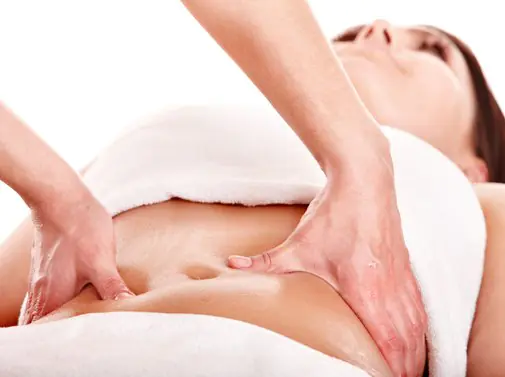
Lymphatic drainage technique removes waste products from the body
- Calf massage
Raise your shin with your left hand and place it at a right angle to your body. Hold the shin with both hands near the ankle. Then use light massaging movements, pressing slowly and moving downwards. Afterwards, return to the starting position and repeat the technique again.
- Forearm massage
The arm should be bent at the elbow, positioned vertically. Wrap your fingers tightly around your hand and form a ring. Using light, gentle pressure, move down towards your elbow.
- Shoulder massage
Grab your partner's shoulder with both hands, bend his arm so that his palm rests on the other shoulder. Wrap your hand tightly in the ring and slowly move down.
Vibration
The process of vibration consists of transmitting oscillatory and trembling movements to a certain part of the body. This technique is very energetic: it improves blood circulation, removes metabolic waste, and relieves muscle tension. In addition, vibration can remove congestion in the lungs.
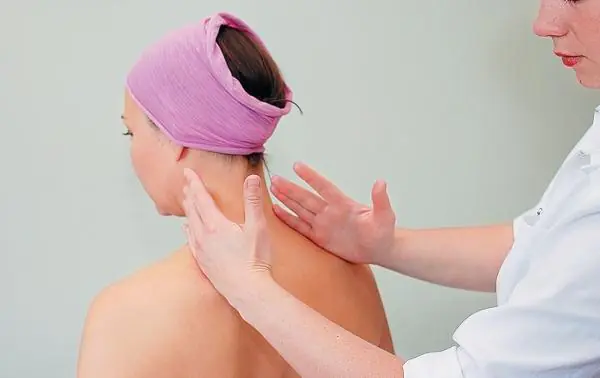
Vibration perfectly relieves muscle tension, improving blood circulation
Patting and tapping movements should be carried out gently and naturally. Vibrating movements should be carried out in a moderate, rhythmic, calm manner, giving pleasure to the person. As soon as you have warmed up your body well enough, feel free to start vibrating movements. Using this technique, you should massage only soft areas of the body. Vibration is divided into: pinching, tapping, chopping, patting.
- Topping
The pinching technique is as follows: you lightly pinch the muscle, then quickly release it. Use this method to cover the entire body area.
- Tapping
Squeeze your fists weakly and begin to quickly “drum” your body.
- Chopping
For this type of massage, you need to relax your hands, keep your fingers free, apply movements only with the edge of your palm, alternately changing hands.
- Pat
You should squeeze your palms into handfuls and quickly pat the skin.
This video will help you understand in more detail how to do a massage correctly.
Correctly performed technique will definitely give a positive result and solve health problems. You need to take care of your health at any age. If you're still neutral about massage, it's time to reconsider your decision and set your priorities.



